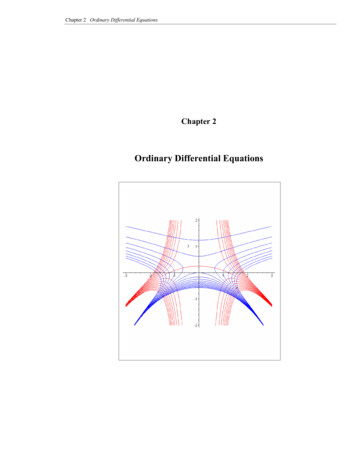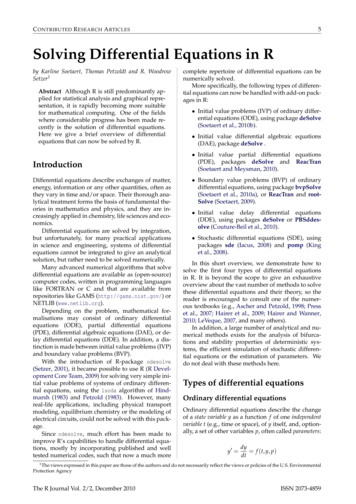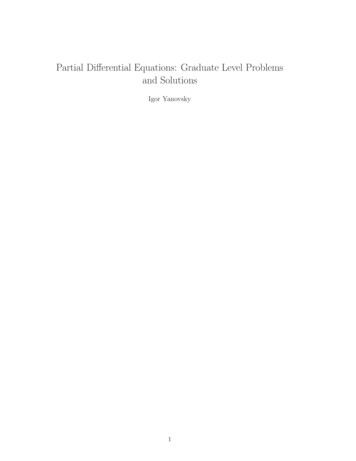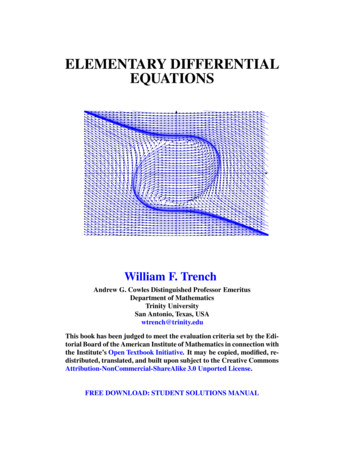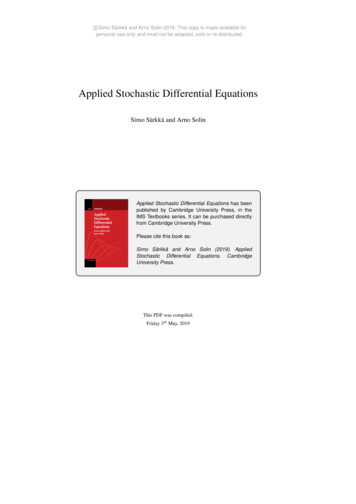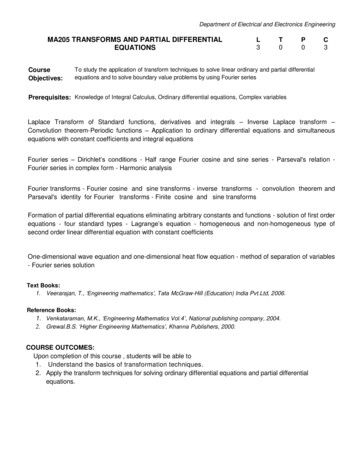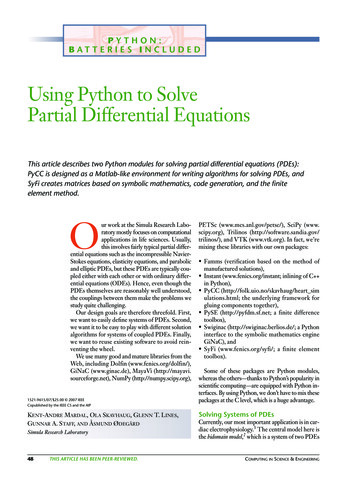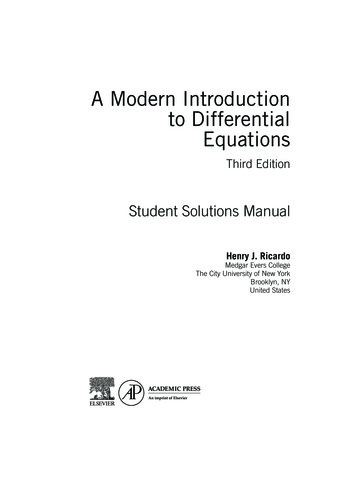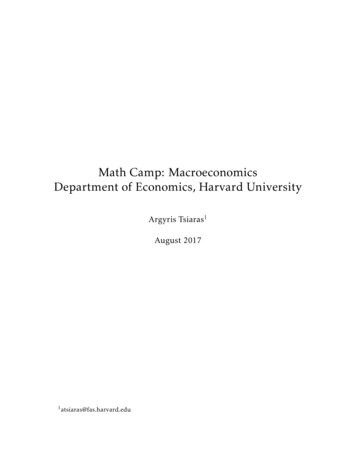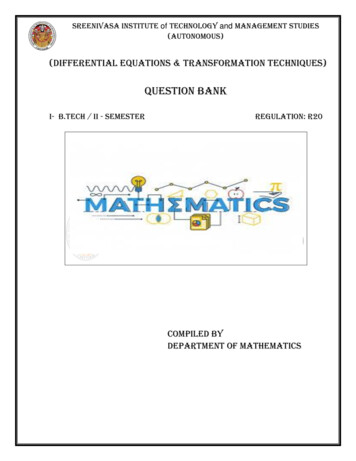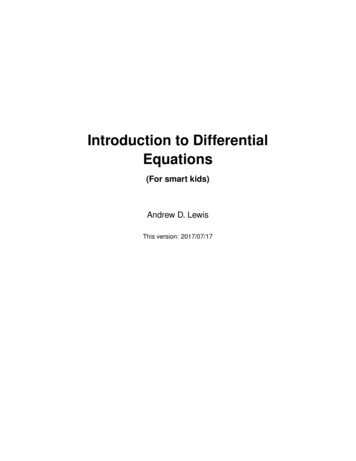
Transcription
Introduction to DifferentialEquations(For smart kids)Andrew D. LewisThis version: 2017/07/17
2
iPrefaceThis book is intended to be suggest a revision of the way in which the firstcourse in differential equations is delivered to students, normally in their secondyear of university. This course has traditionally grown as an offshoot of the calculuscourses taught in the first year, where students often learn some techniques andtricks for solving specific problems, e.g., for computing specific derivatives andintegrals. This is not an entirely unreasonable thing to do, since it is difficult toimagine being able to practice mathematics without being able to handle calculuswith some of the basic special functions one encounters in a first course.1 Moreover,a first calculus course often comes complete with many insights into the meaningof, and uses of, differentiation and integration. However, this “techniques andtricks” method becomes less valuable for ordinary differential equations. The factis that there are very few differential equations that can be solved, and those thatcan be solved only succumb after quite a lot of work.2 Thus, while I do believe it isessential to be able to solve a number of differential equations “by inspection”—andI expect students taking the course for which this is the text to be able to dothis—the proliferation of computer packages to carry out efficiently and effectivelythe tedious computations typically learnt in a differential equations course makesone reconsider why we teach students multiple ways to solve the same small setof differential equations. This text is the result of my own reconsideration of thetraditional first course in differential equations.As an instructor, the question becomes, “If I do not teach all of the usualtechniques and tricks for solving differential equations, what do I replace it with?”My choices for answers to this question are the following.1. Make sure students know that differential equations arise naturally in a wide varietyof fields, including the sciences, engineering, and the social sciences. This is done bystarting the text with a long list of examples of models involving differentialequations. For some of these, we are able to provide a pretty complete rationalefor where the equations come from, and in some cases we can make predictionsbased on our human experience about how solutions of these differential equations may behave. However, in some cases we are merely able to describe inplain English what the equations represent, and then just write them down. But,1That being said, the following conversation happens in most courses I teach:Me: Oh no, an integral! Class, how do we solve integrals?Class: Google! Wolfram Alpha!Me: Correct!2And so we have. . .Me: Oh no, a differential equation! Class, how do we solve differential equations?Class: Google! Wolfram Alpha!Me: Correct!
iiat the end of the day, we produce a long list of differential equations of variouskinds. Thus we do not restrict ourselves to modelling involving simple differential equations, but also provide some impossibly complicated differentialequations so that the subject is not oversimplified.And this leads to the following choice.2. Make sure students know what a differential equation is. A differential equationis normally written as just that: an equation. The problem with this is thatequations are not really mathematically useful. When one writes down anequation with an unknown, this is something to be solved, not something to beunderstood. Thus we demur from just writing differential equations, and definethem initially as maps whose properties can be enumerated and understood.In treating differential equations in this way, it is seen that there is a commonstarting point for all differential equations, and that the ones that we learn howto solve are very special and degenerate in some way.3. Appreciate how to use a computer when working with differential equations. Becausethere are so few differential equations that can be solved analytically, and alsobecause the analytical solution procedures are often extremely tedious to apply,one may wish to have at hand computer methods for working with differentialequations. Computer packages come in two basic flavours, which give, alongwith some examples of these.I. Computer algebra systems: A computer algebra system can typically find analytic solutions to differential equations, when these can be easily found.For example, any decent computer algebra system can solve any differential equation we solve using the methods in this book. Some examples ofcommonly-used computer algebra systems are:(a) Maple : http://www.maplesoft.com/(b) Mathematica : http://www.wolfram.com/mathematica/(c) Maxima : http://maxima.sourceforge.net/(d) SageMath : http://www.sagemath.org/II. Numerical computation packages: Even if one cannot use a computer algebra system to obtain analytic solutions to differential equations, one canoften use algorithms that approximate differential equations and producenumerical solutions. This is very often the only thing one is interested inin hardcore applications of differential equations, even in cases where analytical solutions are possible. Some examples of commonly used numericalcomputation packages are:(a) Maple : http://www.maplesoft.com/(b) Mathematica : http://www.wolfram.com/mathematica/(c) Matlab : http://www.mathworks.com/(d) Octave : https://www.gnu.org/software/octave/(e) Scilab : http://www.scilab.org/
iiiAs can be seen, it is often (but not always) the case that a computer algebrasystem offers the facility to do numerical computations with differentialequations, along with that for doing symbolic computations.The above list is by no means an exhaustive accounting of what is available,and for a more complete (but still not complete) list, please visit the appropriateWikipedia pages:https://en.wikipedia.org/wiki/List of computer algebra systemshttps://en.wikipedia.org/wiki/List of numerical analysis softwareWe wish to emphasise that we do not go deeply at all into numerical analysisin this text. Indeed, we use computer packages as a tool, and one must beaware—as when using any tool—of its limitations. However, from a pragmaticpoint of view, computer packages in the present day are so sophisticated thatone typically must go very deeply to see why they might break, and to do so iswell beyond our present scope.4. Understand the character of solutions, rather than just producing their closed-formexpressions. While there is something gratifying in being able to go through along involved process, and arrive at a correct solution to a differential equation,it is far more interesting and useful to be able to understand (a) why the solutionprocess works and (b) what is the character of the solution one obtained. Thus,while we do consider some of the standard methods for solving differentialequations, we do not either start or stop there.5. Introduce transform methods for differential equations, since these are very powerful.However, we do not wish to introduce transform methods as providing analgorithmic procedure for solving (in practice, only very simple) differentialequations. What we wish to do is illustrate, in as general a way as possiblein an introductory text, the raison d’être for transform methods, which is thatthey turn differential equations into algebraic equations, maybe only partiallyso. Thus we introduce a variety of transforms used in a variety of problems.This is Version 1 of these notes, so please indicate errors or suggestions forimprovements.Andrew D. LewisKingston, Ontario, Canada
iv
Table of Contents1What are differential equations?1.1 How do differential equations arise in mathematical modelling? . .1.1.1 Mass-spring-damper systems . . . . . . . . . . . . . . . . . .1.1.2 The motion of a simple pendulum . . . . . . . . . . . . . . . .1.1.3 Bessel’s equation . . . . . . . . . . . . . . . . . . . . . . . . . .1.1.4 RLC circuits . . . . . . . . . . . . . . . . . . . . . . . . . . . . .1.1.5 Tank systems . . . . . . . . . . . . . . . . . . . . . . . . . . . .1.1.6 Population models . . . . . . . . . . . . . . . . . . . . . . . . .1.1.7 Economics models . . . . . . . . . . . . . . . . . . . . . . . . .1.1.8 Euler–Lagrange equations . . . . . . . . . . . . . . . . . . . .1.1.9 Maxwell’s equations . . . . . . . . . . . . . . . . . . . . . . . .1.1.10 The Navier–Stokes equations . . . . . . . . . . . . . . . . . . .1.1.11 Heat flow due to temperature gradients . . . . . . . . . . . .1.1.12 Waves in a taut string . . . . . . . . . . . . . . . . . . . . . . .1.1.13 The potential equation in electromagnetism and fluid mechanics . . . . . . . . . . . . . . . . . . . . . . . . . . . . . . .1.1.14 Einstein’s field equations . . . . . . . . . . . . . . . . . . . . .1.1.15 The Schrödinger equation . . . . . . . . . . . . . . . . . . . .1.1.16 The Black–Scholes equation . . . . . . . . . . . . . . . . . . .1.1.17 Summary . . . . . . . . . . . . . . . . . . . . . . . . . . . . . .1.1.18 Notes . . . . . . . . . . . . . . . . . . . . . . . . . . . . . . . .1.2 The mathematical background and notation required to read this text1.2.1 Elementary mathematical notation . . . . . . . . . . . . . . .1.2.2 Complex numbers . . . . . . . . . . . . . . . . . . . . . . . . .1.2.2.1 Complex arithmetic . . . . . . . . . . . . . . . . . . .1.2.2.2 Polar representation . . . . . . . . . . . . . . . . . .1.2.2.3 Roots of complex numbers . . . . . . . . . . . . . . .1.2.3 Polynomials . . . . . . . . . . . . . . . . . . . . . . . . . . . .1.2.4 Linear algebra . . . . . . . . . . . . . . . . . . . . . . . . . . .1.2.4.1 Vector spaces and subspaces . . . . . . . . . . . . . .1.2.4.2 Linear independence and bases . . . . . . . . . . . .1.2.4.3 Linear maps . . . . . . . . . . . . . . . . . . . . . . .1.2.4.4 Affine maps and inhomogeneous linear equations .1.2.4.5 Eigenvalues and eigenvectors . . . . . . . . . . . . .1.2.4.6 Internal and external direct sums . . . . . . . . . . .1.2.4.7 Complexification . . . . . . . . . . . . . . . . . . . .1.2.4.8 Multilinear maps . . . . . . . . . . . . . . . . . . . 43435363941414242
vi1.31.421.2.5 Calculus . . . . . . . . . . . . . . . . . . . . . . . . . . . . . . .1.2.6 Real analysis . . . . . . . . . . . . . . . . . . . . . . . . . . . .Classification of differential equations . . . . . . . . . . . . . . . . . .1.3.1 Variables in differential equations . . . . . . . . . . . . . . . .1.3.2 Differential equations and solutions . . . . . . . . . . . . . . .1.3.3 Ordinary differential equations . . . . . . . . . . . . . . . . .1.3.3.1 General ordinary differential equations . . . . . . .1.3.3.2 Linear ordinary differential equations . . . . . . . .1.3.4 Partial differential equations . . . . . . . . . . . . . . . . . . .1.3.4.1 General partial differential equations . . . . . . . . .1.3.4.2 Linear and quasilinear partial differential equations1.3.4.3 Elliptic, hyperbolic, and parabolic second-orderlinear partial differential equations . . . . . . . . . .1.3.5 How to think about differential equations . . . . . . . . . . .The question of existence and uniqueness of solutions . . . . . . . .1.4.1 Existence and uniqueness of solutions for ordinary differential equations . . . . . . . . . . . . . . . . . . . . . . . . . . . .1.4.1.1 Examples motivating existence and uniqueness ofsolutions for ordinary differential equations . . . . .1.4.1.2 Principal existence and uniqueness theorems forordinary differential equations . . . . . . . . . . . .1.4.1.3 Flows for ordinary differential equations . . . . . .1.4.2 Existence and uniqueness of solutions for partial differentialequations. . . NOT!! . . . . . . . . . . . . . . . . . . . . . . . . .Scalar ordinary differential equations2.1 Separable first-order scalar equations . . . . . . . . . . . . . . . . .2.2 Scalar linear homogeneous ordinary differential equations . . . . .2.2.1 Equations with time-varying coefficients . . . . . . . . . . .2.2.1.1 Solutions and their properties . . . . . . . . . . . .2.2.1.2 The Wronskian, and its properties and uses . . . .2.2.2 Equations with constant coefficients . . . . . . . . . . . . . .2.2.2.1 Complexification of scalar linear ordinary differential equations . . . . . . . . . . . . . . . . . . . . .2.2.2.2 Differential operator calculus . . . . . . . . . . . .2.2.2.3 Bases of solutions . . . . . . . . . . . . . . . . . . .2.2.2.4 Some examples . . . . . . . . . . . . . . . . . . . .2.3 Scalar linear inhomogeneous ordinary differential equations . . . .2.3.1 Equations with time-varying coefficients . . . . . . . . . . .2.3.1.1 Solutions and their properties . . . . . . . . . . . .2.3.1.2 Finding a particular solution using the Wronskian2.3.1.3 The Green’s function . . . . . . . . . . . . . . . . .2.3.2 Equations with constant coefficients . . . . . . . . . . . . . 118118122127.128129131135143143143146148155
vii2.432.3.2.1 The “method of undetermined coefficients” . . . . . 1562.3.2.2 Some examples . . . . . . . . . . . . . . . . . . . . . 160Using a computer to work with scalar ordinary differential equations1712.4.1 The basic idea of numerically solving differential equations . 1712.4.2 Using Mathematica to obtain analytical and/or numericalsolutions . . . . . . . . . . . . . . . . . . . . . . . . . . . . . . 1722.4.3 Using Matlab to obtain numerical solutions . . . . . . . . . 176Systems of ordinary differential equations3.1 Linearisation . . . . . . . . . . . . . . . . . . . . . . . . . . . . . . .3.1.1 Linearisation along solutions . . . . . . . . . . . . . . . . . .3.1.2 Linearisation about equilibria . . . . . . . . . . . . . . . . .3.1.3 The flow of the linearisation . . . . . . . . . . . . . . . . . .3.1.4 While we’re at it: ordinary differential equations of class Cm3.2 Systems of linear homogeneous ordinary differential equations . .3.2.1 Working with general vector spaces . . . . . . . . . . . . . .3.2.2 Equations with time-varying coefficients . . . . . . . . . . .3.2.2.1 Solutions and their properties . . . . . . . . . . . .3.2.2.2 The state transition map . . . . . . . . . . . . . . .3.2.2.3 The Peano–Baker series . . . . . . . . . . . . . . .3.2.2.4 The adjoint equation . . . . . . . . . . . . . . . . .3.2.3 Equations with constant coefficients . . . . . . . . . . . . . .3.2.3.1 Invariant subspaces associated with eigenvalues .3.2.3.2 Invariant subspaces of R-linear maps associatedwith complex eigenvalues . . . . . . . . . . . . . .3.2.3.3 The Jordan canonical form . . . . . . . . . . . . . .3.2.3.4 Complexification of systems of linear ordinary differential equations . . . . . . . . . . . . . . . . . .3.2.3.5 The operator exponential . . . . . . . . . . . . . .3.2.3.6 Bases of solutions . . . . . . . . . . . . . . . . . . .3.2.3.7 Some examples . . . . . . . . . . . . . . . . . . . .3.3 Systems of linear inhomogeneous ordinary differential equations .3.3.1 Equations with time-varying coefficients . . . . . . . . . . .3.3.2 Equations with constant coefficients . . . . . . . . . . . . . .3.4 Phase-plane analysis . . . . . . . . . . . . . . . . . . . . . . . . . . .3.4.1 Phase portraits for linear systems . . . . . . . . . . . . . . .3.4.1.1 Stable nodes . . . . . . . . . . . . . . . . . . . . . .3.4.1.2 Unstable nodes . . . . . . . . . . . . . . . . . . . .3.4.1.3 Saddle points . . . . . . . . . . . . . . . . . . . . .3.4.1.4 Centres . . . . . . . . . . . . . . . . . . . . . . . . .3.4.1.5 Stable spirals . . . . . . . . . . . . . . . . . . . . .3.4.1.6 Unstable spirals . . . . . . . . . . . . . . . . . . . .3.4.1.7 Nonisolated equilibria . . . . . . . . . . . . . . . .180183183186189202205205207207211217220224224. 230. 86
viii3.4.23.54An introduction to phase portraits for nonlinear systems . .3.4.2.1 Phase portraits near equilibrium points . . . . . .3.4.2.2 Periodic orbits . . . . . . . . . . . . . . . . . . . . .3.4.2.3 Attractors . . . . . . . . . . . . . . . . . . . . . . .3.4.3 Extension to higher dimensions . . . . . . . . . . . . . . . .3.4.3.1 Behaviour near equilibria . . . . . . . . . . . . . .3.4.3.2 Attractors . . . . . . . . . . . . . . . . . . . . . . .Using a computer to work with systems of ordinary differentialequations . . . . . . . . . . . . . . . . . . . . . . . . . . . . . . . . .3.5.1 Using Mathematica to obtain analytical and/or numericalsolutions . . . . . . . . . . . . . . . . . . . . . . . . . . . . .3.5.2 Using Matlab to obtain numerical solutions . . . . . . . .Stability theory for ordinary differential equations4.1 Stability definitions . . . . . . . . . . . . . . . . . . . . . . . . . . . .4.1.1 Definitions . . . . . . . . . . . . . . . . . . . . . . . . . . . .4.1.2 Examples . . . . . . . . . . . . . . . . . . . . . . . . . . . . .4.2 Stability of linear ordinary differential equations . . . . . . . . . . .4.2.1 Special stability definitions for linear equations . . . . . . .4.2.2 Stability theorems for linear equations . . . . . . . . . . . .4.2.2.1 Equations with constant coefficients . . . . . . . .4.2.2.2 Equations with time-varying coefficients . . . . .4.2.2.3 Hurwitz polynomials . . . . . . . . . . . . . . . . .4.3 Lyapunov’s Second Method . . . . . . . . . . . . . . . . . . . . . . .4.3.1 Positive-definite and decrescent functions . . . . . . . . . .4.3.1.1 Class K-, class L-, and class KL-functions . . . . .4.3.1.2 General time-invariant functions . . . . . . . . . .4.3.1.3 General time-varying functions . . . . . . . . . . .4.3.1.4 Time-invariant quadratic functions . . . . . . . . .4.3.1.5 Time-varying quadratic functions . . . . . . . . .4.3.2 Stability in terms of class K- and class KL-functions . . . .4.3.3 The Second Method for nonautonomous equations . . . . .4.3.4 The Second Method for autonomous equations . . . . . . .4.3.5 The Second Method for time-varying linear equations . . .4.3.6 The Second Method for linear equations with constant coefficients . . . . . . . . . . . . . . . . . . . . . . . . . . . . . . .4.3.7 Invariance principles . . . . . . . . . . . . . . . . . . . . . .4.3.7.1 Invariant sets and limit sets . . . . . . . . . . . . .4.3.7.2 Invariance principle for autonomous equations . .4.3.7.3 Invariance principle for linear equations with constant coefficients . . . . . . . . . . . . . . . . . . . .4.3.8 Instability theorems . . . . . . . . . . . . . . . . . . . . . . .4.3.8.1 Instability theorem for autonomous equations . .287288288288288288288. 289. 289. 61364367376388395.401407407409. 411. 414. 415
ix4.3.8.24.456Instability theorem for linear equations with constant coefficients . . . . . . . . . . . . . . . . . . . . . 4164.3.9 Converse theorems . . . . . . . . . . . . . . . . . . . . . . . . 4184.3.9.1 Converse theorems for nonautonomous equations . 4184.3.9.2 Converse theorems for autonomous equations . . . 4244.3.9.3 Converse theorem for time-varying linear equations 4274.3.9.4 Converse theorem for linear equations with constant coefficients . . . . . . . . . . . . . . . . . . . . . 429Lyapunov’s First (or Indirect) Method . . . . . . . . . . . . . . . . . . 4354.4.1 The First Method for nonautonomous equations . . . . . . . 4354.4.2 The First Method for autonomous equations . . . . . . . . . . 4384.4.3 An instability theorem . . . . . . . . . . . . . . . . . . . . . . 4404.4.4 A converse theorem . . . . . . . . . . . . . . . . . . . . . . . . 441Transform methods for differential equations5.1 The Fourier and Laplace transforms . . . . . . . . . . . . . . . . . .5.1.1 The continuous-discrete Fourier transform . . . . . . . . . .5.1.1.1 The transform . . . . . . . . . . . . . . . . . . . . .5.1.1.2 The inverse transform . . . . . . . . . . . . . . . .5.1.1.3 Convolution and the continuous-discrete Fouriertransform . . . . . . . . . . . . . . . . . . . . . . .5.1.1.4 Extension to higher-dimensions . . . . . . . . . . .5.1.2 The continuous-continuous Fourier transform . . . . . . . .5.1.2.1 The transform . . . . . . . . . . . . . . . . . . . . .5.1.2.2 The inverse transform . . . . . . . . . . . . . . . .5.1.2.3 Convolution and the continuous-continuousFourier transform . . . . . . . . . . . . . . . . . . .5.1.2.4 Extension to higher-dimensions . . . . . . . . . . .5.1.3 The Laplace transform . . . . . . . . . . . . . . . . . . . . .5.1.3.1 The transform . . . . . . . . . . . . . . . . . . . . .5.1.3.2 The inverse transform . . . . . . . . . . . . . . . .5.1.3.3 Convolution and the Laplace transform . . . . . .5.1.3.4 Extension to higher-dimensions . . . . . . . . . . .5.2 Laplace transform methods for ordinary differential equations . .5.2.1 Scalar homogeneous equations . . . . . . . . . . . . . . . . .5.2.2 Scalar inhomogeneous equations . . . . . . . . . . . . . . .5.2.3 Systems of homogeneous equations . . . . . . . . . . . . . .5.2.4 Systems of inhomogeneous equations . . . . . . . . . . . . .5.3 Fourier transform methods for differential equations . . . . . . . 8469472472477480483488An introduction to partial differential equations4896.1 Characteristics of partial differential equations . . . . . . . . . . . . . 4926.1.1 Characteristic for linear partial differential equations . . . . . 492
x6.26.36.46.56.676.1.2 Characteristics for quasilinear partial differential equations6.1.3 Characteristics for nonlinear partial differential equations .6.1.4 The Cauchy–Kovalevskaya Theorem . . . . . . . . . . . . .First-order partial differential equations . . . . . . . . . . . . . . . .6.2.1 The Method of Characteristics for first-order equations . . .6.2.2 First-order conservation laws . . . . . . . . . . . . . . . . .The heat equation . . . . . . . . . . . . . . . . . . . . . . . . . . . .6.3.1 Characteristics for the heat equation . . . . . . . . . . . . .6.3.2 The heat equation for a finite length rod . . . . . . . . . . .6.3.2.1 Formal solution . . . . . . . . . . . . . . . . . . . .6.3.2.2 Rigorous establishment of solutions . . . . . . . .6.3.3 The heat equation for an infinite length rod . . . . . . . . .6.3.3.1 Formal solution . . . . . . . . . . . . . . . . . . . .6.3.3.2 Rigorous establishment of solutions . . . . . . . .The wave equation . . . . . . . . . . . . . . . . . . . . . . . . . . . .6.4.1 Characteristics for the wave equation . . . . . . . . . . . . .6.4.2 The wave equation for a finite length string . . . . . . . . .6.4.2.1 Formal solution . . . . . . . . . . . . . . . . . . . .6.4.2.2 Rigorous establishment of solutions . . . . . . . .6.4.3 The wave equation for an infinite length string . . . . . . .6.4.3.1 Formal solution . . . . . . . . . . . . . . . . . . . .6.4.3.2 Rigorous establishment of solutions . . . . . . . .The potential equation . . . . . . . . . . . . . . . . . . . . . . . . . .6.5.1 Characteristics for the potential equation . . . . . . . . . . .6.5.2 The potential equation for a bounded rectangle . . . . . . .6.5.2.1 Formal solution . . . . . . . . . . . . . . . . . . . .6.5.2.2 Rigorous establishment of solutions . . . . . . . .6.5.3 The potential equation for a semi-unbounded rectangle . .6.5.3.1 Formal solution . . . . . . . . . . . . . . . . . . . .6.5.3.2 Rigorous establishment of solutions . . . . . . . .6.5.4 The potential equation for an unbounded rectangle . . . . .6.5.4.1 Formal solution . . . . . . . . . . . . . . . . . . . .6.5.4.2 Rigorous establishment of solutions . . . . . . . .Weak solutions of partial differential equations . . . . . . . . . . .Second-order boundary value problems7.1 Linear maps on Banach and Hilbert spaces . . .7.1.1 Linear maps on normed vector spaces .7.1.1.1 Continuous linear maps . . . .7.1.1.2 Linear operators . . . . . . . . .7.1.1.3 Invertibility of linear operators7.1.1.4 Linear functions . . . . . . . . .7.1.2 Linear maps on inner product spaces . 527.528530530530535540543544
xi7.27.37.1.2.1 The adjoint of a continuous linear map . . . . . . . 5447.1.2.2 The adjoint of a linear operator . . . . . . . . . . . . 5457.1.2.3 Alternative theorems . . . . . . . . . . . . . . . . . . 5507.1.3 Spectral properties of linear operators . . . . . . . . . . . . . 5507.1.3.1 Spectral properties for operators on Banach spaces . 5507.1.3.2 Spectral properties for operators on Hilbert spaces . 553Second-order regular boundary value problems . . . . . . . . . . . . 5607.2.1 Introductory examples . . . . . . . . . . . . . . . . . . . . . . 5607.2.1.1 Some structure for a simple boundary value problem5607.2.1.2 A boundary value problem with peculiar eigenvalues5657.2.2 Sturm-Liouville problems . . . . . . . . . . . . . . . . . . . . . 5687.2.2.1 Second-order boundary value problems . . . . . . . 5687.2.2.2 A general eigenvalue problem . . . . . . . . . . . . 5717.2.3 The Green function and completeness of eigenfunctions . . . 5747.2.3.1 The Green function . . . . . . . . . . . . . . . . . . . 5757.2.3.2 Completeness of eigenfunctions . . . . . . . . . . . 5807.2.4 Approximate behaviour of eigenvalues and eigenfunctions . 5907.2.4.1 Eigenvalue properties . . . . . . . . . . . . . . . . . 5907.2.4.2 Eigenfunction properties . . . . . . . . . . . . . . . . 5957.2.5 Summary . . . . . . . . . . . . . . . . . . . . . . . . . . . . . . 5957.2.6 Notes . . . . . . . . . . . . . . . . . . . . . . . . . . . . . . . . 596Second-order singular boundary value problems . . . . . . . . . . . 6017.3.1 Classification of boundary value problems . . . . . . . . . . . 6017.3.1.1 Regular and singular boundary value problems . . 6017.3.1.2 The limit-point and limit-circle cases . . . . . . . . . 6057.3.2 Eigenvalues and eigenfunctions for singular problems . . . . 6087.3.2.1 Basic properties . . . . . . . . . . . . . . . . . . . . . 6097.3.2.2 Classification by spectral properties . . . . . . . . . 6117.3.3 The theory for singular boundary value problems . . . . . . . 6117.3.3.1 Problems defined on [0, ) . . . . . . . . . . . . . . 6117.3.3.2 Problems defined on ( , ) . . . . . . . . . . . . . 6127.3.4 Applications that yield singular boundary value problems . 6127.3.4.1 The vibrating of a drum . . . . . . . . . . . . . . . . 6127.3.4.2 The Laplacian in spherical coordinates . . . . . . . . 6157.3.4.3 The approximate age of the earth . . . . . . . . . . . 6177.3.5 Summary . . . . . . . . . . . . . . . . . . . . . . . . . . . . . . 6217.3.6 Notes . . . . . . . . . . . . . . . . . . . . . . . . . . . . . . . . 622
xii
Chapter 1What are differential equations?In this chapter we provide what we hope is a substantial backdrop and motivation for the study of differential equations. We do this first, in Section 1.1, byconsidering an array of physical systems that are modelled by differential equations. While we provide a diverse collection of such motivating examples, the factof the matter is that this is a pitifully small sampling of the ways in which differentialequations arise in modelling. Nonetheless, we hope that we can justify a broad andvague assertion like, “Differential equations are endemic in mathematical modelsof the physical world.”As we shall see in Section 1.3, differential equations come in various flavours.The two main branches in the classification tree for differential equations are “ordinary differential equations” and “partial differential equations.” In these noteswe will primarily consider short twigs coming off each of these two branches, corresponding to “linear” differential equations. However, it is extremely importantto realise that, while linear differential equations are of fundamental importance inthe general theory, many, many differential equations encountered in practice arenot linear. Thus a good understanding of just what a linear differential equation isis essential.In the final section of this chapter, we consider two important questions: (1) dodifferential equations possess solutions? (2) if a differential equation possesses asolution, is it unique? We shall see that the answer to both questions is generally,“No,” but that under very weak hypotheses this answer is, “Yes,” at least forordinary differential equations. (These questions for partial differential equationsare far more sinister, at least if one wishes to pursue any degree of generality.)We also provide, in Section 1.2, an overview of the mathematical backgroundwe will use. Most of this will have been acquired by a typical second-year student,although perhaps not with the degree of notational precision we require. There isalso likely to be a few topics that are not a part of the standard background of asecond-year student, and so some parts of this section may be new.Contents1.1How do differential equations arise in mathematical modelling? . . . . . . . . .4
21.21.31 What are differential equations?1.1.1 Mass-spring-damper systems . . . . . . . . . . . . . . . . . . . . .1.1.2 The motion of a simple pendulum . . . . . . . . . . . . . . . . . .1.1.3 Bessel’s equation . . . . . . . . . . . . . . . . . . . . . . . . . . . .1.1.4 RLC circuits . . . . . . . . . . . . . . . . . . . . . . . . . . . . . . .1.1.5 Tank systems . . . . . . . . . . . . . . . . . . . . . . . . . . . . . .1.1.6 Population models . . . . . . . . . . . . . . . . . . . . . . . . . . .1.1.7 Economics models . . . . . . . . . . . . . . . . . . . . . . . . . . .1.1.8 Euler–Lagrange equations . . . . . . . . . . . . . . . . . . . . . . .1.1.9 Maxwell’s equations . . . . . . . . . . . . . . . . . . . . . . . . . .1.1.10 The Nav
I. Computer algebra systems: A computer algebra system can typically find an-alytic solutions to di erential equations, when these can be easily found. For example, any decent computer algebra system can solve any di eren-tial equation we solve using the methods in this book. Some examples of

